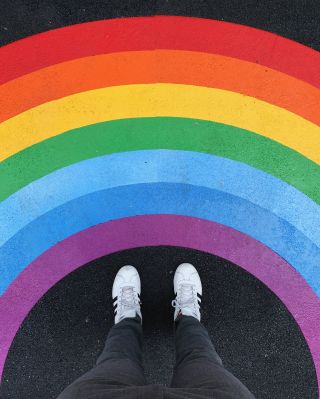Identity
Understanding and Celebrating Pride Flags
Pride flags continue evolving to reflect the diversity of LGBTQ+ people.
Updated October 3, 2023 Reviewed by Jessica Schrader
Key points
- Pride flags are a unifying symbol during LGBTQ+ History Month and all year round.
- October 11 is National Coming Out Day. Pride flags are affirming of the diverse sexual and gender identities.
- Pride flags are back in the media spotlight due to recent high-profile incidents.

"One of the issues that bothers me the most ... is that when entering the United Nations General Assembly, you see the LGBT colors on steps and other places," said Turkish President Recep Tayyip Erdogan last week. His headline-making complaints decried the UN headquarter’s colors for resembling the rainbow Pride flag. A month earlier, Laura Ann Carleton, a mother of nine, was shot dead for flying a rainbow flag in Lake Arrowhead, California. In June this year, some people posted on social media a picture of the Pride flags in Oxford Street in London celebrating Pride Month juxtapositioned with a picture of the Nazi flags in Berlin during the regime in WW2 with a caption alluding to equating the two as the same indoctrination or propaganda. Pride flags serve as important, unifying LGBTQ+ symbols. These events have placed the public’s attention on Pride flags. As October is LGBTQ+ History Month in the USA (February in the UK) and October 11 is National Coming Out Day, Pride flags may again be back in the spotlight.
Why Flags Are Meaningful and Important
Flags are unifying symbols. They are meant to be flown with pride. Sports fans at international competitions fly their country’s national flags. Members of the LGBTQ+ community fly Pride flags during parades. Researchers of flags explain: “Flags are explained as symbols of group solidarity that achieve force through ritual processes.”
Coming out of the closet, or “coming out,” is important to the mental health and well-being of LGBTQ+ people. In fact, when compared to closeted LGBTQ+ people, openly LGBTQ+ people have “lower stress hormone levels and fewer symptoms of anxiety, depression, and burnout.” Coming out is easier in a visibly supportive community that outwardly supports LGBTQ+ people. A community can communicate LGBTQ+ inclusivity by displaying pride flags and celebrating LGBTQ+ History Month and National Coming Out Day.
The pride flag is important for the marginalised queer communities because it can represent a place of belonging and “home.” Identifying the pride flag as our own can foster a sense of togetherness, which can increase our resilience while trying to navigate a homophobic, biphobic, and transphobic world. Sometimes, the flag can be a beacon of hope when LGBTQ+ people feel isolated or are in an environment that doesn’t accept them fully. It signifies: “You’re not alone, there are others like you, there is a family of choice under this flag that can accept and love you.” That sense of hope makes the difference in continuing to survive an inhospitable environment until such a family of choice is found.
The History of the Pride Flag
American LGBTQ+ activist Gilbert Baker created the first pride flag in 1978. Each of its eight colors represented different things: pink for sexuality, red for life, orange for healing, yellow for the sun, green for nature, turquoise for magic, blue for peace, and purple for the human spirit.
“There was a time when the LGBTQ+ community lacked a visual symbol that would later unite and represent us,” said Vic Basile, the Human Rights Campaign’s (HRC) first executive director and author of Bending Toward Justice. “When I started work as the first executive director of the HRC in 1983, symbols of the LGBTQ+ community at the time were different from what they are now. Back then, the symbols we had were the logos of the very few LGBTQ organizations that existed at the time. And these logos were certainly not widely known or disseminated.”
Forty-five years since Gilbert Baker created the original flag, the rainbow colors and newer iterations of it remain an easily recognizable—and global—symbol for LGBTQ+ people. When Taiwan became the first country in Asia to legalize same-sex marriage in 2019, thousands of Taiwanese carried rainbow flags and maps of Taiwan decorated in rainbows to the streets of Taipei.
The Evolution of the Pride Flags: Understanding the Different Flags and Their Meanings
According to experts, a way to practice allyship is to recognize that the LGBTQ+ community is highly diverse and to learn about the different flags representing different groups.
Robert Conner, an expert in LGBTQ+ communications who authored guidelines on how corporations should communicate during June’s Pride Month, said, “A good ally understands that different pride flags exist. A great ally can identify different types of pride flags, especially the ones used by their LGBTQ+ friends.”
Conner explained, “There are flags that are meant to represent the entire LGBTQ+ community, such as the Gilbert Baker Pride Flag and the Progress Pride Flag, and, there are also flags that represent sexual orientations.” According to the HRC’s LGBTQ+ Pride Flags resource page, flags that represent sexual orientation are the: Lesbian Pride Flag, Trans-Inclusive Gay Men's Pride Flag, Bisexual Pride Flag, Pansexual Pride Flag, Asexual Pride Flag, Demisexual Pride Flag, Polyamory Pride Flag, and Polysexual Pride Flag.
“There are also at least eight flags that represent gender identity and gender expression, such as the Transgender Pride Flag and the Genderqueer Pride Flag,” Conner added.
How Pride Flags Can Be Used
The goals of October 11’s annual National Coming Out Day closely mirror the reason why LGBTQ+ people fly pride flags: to spread awareness and unity. Psychologist Dr. Robert Eichberg, co-founder of National Coming Out Day, said in a 1993 interview, “It is imperative that we come out and let people know who we are and disabuse them of their fears and stereotypes.”
Experts believe that visual symbols such as flags spread positive messages, easing the coming out process. “Pride flags are not just symbolic. They are practical, too. A person feels more supported to come out in a space that visibly displays pride flags,” explained Conner. “National Coming Out Day is an appropriate time to show your friends that they can safely come out to you. Don’t ask if they are queer. Instead, start a conversation by talking about the different pride flags.”
Because of how prevalent Pride Month is now celebrated, schools and companies hesitate to observe LGBTQ+ events that are outside of June. Some school boards in America have banned LGBTQ+ History Month.
Conner said, “Year-round allyship is imperative. October’s LGBTQ+ History Month is an opportune time to be an ally. Learn about historical figures such as Harvey Milk, Gilbert Baker, Marsha P. Johnson, and Bayard Rustin.”
The biographies of historical LGBTQ+ figures are available through free online resources such as LGBTHistoryMonth.com. Conner urged, “In addition to displaying pride flags, leaders of schools and companies should distribute resources to explain the different kinds of pride flags. Learning about these flags also means learning about sexual orientations, gender identities, and kinds of gender expression.”
Basile, having been on the frontlines of LGBTQ+ activism for four decades, said, “Now, I’m delighted that the LGBTQ+ community has a multitude of different flags, including the equal sign for equality that has represented the HRC since 1995, as well as specific flags for each letter of the LGBTQ+ acronym."
While Tukey’s president Erdogan is one reminder of how an anti-LGBTQ+ person gets “triggered” just by seeing rainbow colors, activists and experts continue stressing the importance of positive symbols like pride flags. In LGBTQ+ History Month, LGBTQ+ people and allies can again choose which flags to fly, and embrace unapologetic pride in who they are.
References




